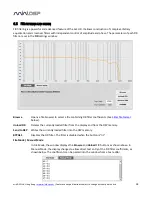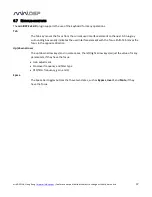
miniDSP Ltd, Hong Kong /
www.minidsp.com
/ Features and specifications subject to change without prior notice
33
6.5.1
FIR filtering overview
FIR ("finite impulse response") filtering differs from the IIR ("infinite impulse response") filters used in the PEQ
and crossover blocks. Technically speaking, IIR filters are
recursive
, meaning that each output value is partially
calculated from earlier output values as well as from input values. An FIR filter is specified by a large array of
numbers, whereas an IIR filter requires only a fairly small of values to be specified.
These numbers are conventionally referred to as "taps." The 2x4 HD can compute a total of 4096 taps. These
taps can be distributed as you wish across the four output channels, with the limitation that each output
channel must have 6 or more taps and can have no more than 2048 taps. The decision on how many taps to
allocate to each channel up to you, and should be determined after working with an FIR filter design program
(see below). The number of taps is set in the lower right corner (click on the text entry box and type the desired
number of taps, then press
Tab
or
Return
):
6.5.2
FIR filter design software
The filter coefficients must be created with the aid of filter design software. miniDSP does not provide any such
software, instead referring you to the many software packages available for this purpose (both freeware and
commercial). Please see the
FIR filter tools
page on our website.
6.5.3
Filter file format
The filter coefficient file loaded in
File Mode
uses
IEEE 754 single-precision binary floating-point format
. The
number of entries in the file must not exceed the allocated number of taps.
In Manual Mode, the coefficients must be plain text in this format:
b0 = 1,
b1 = -1,
b2 = 0.5,
b3 = -0.5,
b4 = 0.2,
b5 = 1,
















































